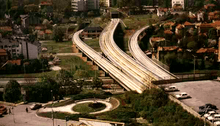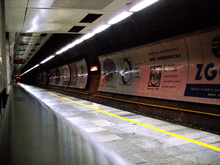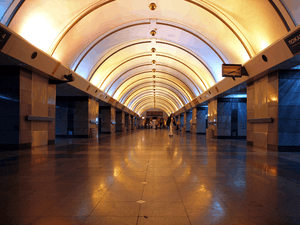Belgrade railway junction

The Belgrade railway junction (Serbian language Београдски железнички чвор, Beogradski železnički čvor) is a large-scale reconstruction of the railroad network in Belgrade, Serbia. It was launched 1971 with works officially starting 1974 with the construction of the New Railroad Bridge. The central part of the scheme is formed by the Prokop railway station which is served via three tunnels beneath the city center.
Construction of the Belgrade railway junction was mostly completed with the opening of the Vukov spomenik underground passenger station 1995. As the completion of the Prokop railway station was severely delayed due to lack in funding the network, which was planned to replace the old railroad network and the historical central station up till today is only used for the Beovoz commuter trains of the suburban modal city network.
Concept

The main feature of the railway scheme is that all railway installations cross the town center underground and do not collide with the urban infrastructure. Three tunnels adding 14 km in length have been constructed. They connect the central railway station at Prokop with the main railroads to the west, north and south of the city.
The Belgrade railway junction is an intermodal project for long distance, suburban and city traffic, including a shunting station with attached tracks a descending ramp, shunting and loading-unloading group of tracks, a locomotive depot, as well as a major passenger station - Beograd Centar - and technical passenger stations. The suburban traffic within the complex runs in three directions with an underground station at Vukov spomenik in downtown Belgrade.
Within the scheme the Belgrade railway junction is serving seven main international railroads with a considerable capacity. Part of the junction are 15 passenger stations, a new marshalling yard serving the international transport Makiš with centralized and automatic management and traffic control and a daily capacity of 600 railway cars. Within the Prokop central station plans to build 120,000 sqm of business space exist.
History
Works began in 1974 by building the bridge across the river Suva and the tunnels Vracar and Dedinje.[1]
Construction
Up-to-date expenditures in the Belgrade Junction exceed US $700 million. The major portion of the funds was spent for the freight facilities and the electrification scheme, while a portion was spent for the construction of the passenger facilities.
Estimated funds for the completion of the junction are 250 million US$, which should be provided from foreign investment and loans. Final date of completion is the year 2010.
In the complex on the part of passenger and goods transport system the following was built: - 15 single-track tunnels (19,744 m), three tunnels for two tracks (4,431 m), and one multitrack tunnel 200 m long; - 36 reinforced concrete prestressed railway bridges of the total length 4,960 m and road area of 65,255 m2. and seven carriageway brides 957 m long and road area of 9,840 m2; - 12 steel single-track bridges of the total length 1,266 m and six bridges for two tracks of total length 2,034 m.[2]
Infrastructure






Tunnels
- Dedinje Tunnel
- Vračar Tunnel
- Karaburma Tunnel
- Senjak Tunnel
- Stadium Tunnel
- Tunnels connecting railroads
- Bifurcation in the Kneževac tunnel
Bridges
- New Railroad Bridge
- Triple Bridge viaduct over Belgrade-Niš Highway
- Viaduct over Rakovica-Resnik railway
- Triple Bridge viaduct over Belgrade-Novi Sad Highway
- Double Bridge viaduct over Boulevard of Patriarch Pavle
Railway stations
- Zemun railway station
- Prokop railway station
- Rakovica railway station
- Vukov Spomenik railway station
- Pančevo Bridge railway station
- Karađorđe's Park railway station
- Tošin Bunar railway station
- Kneževac railway station
- Batajnica railway station
- Zemun Polje railway station
- Resnik railway station
- Barajevo railway station
Technical and freight stations
- Zemun technical railway station
- Kijevo technical railway station
- Makiš loco-freight station
Railways
- Belgrade Centre - Novi Beograd - Zemun - Batajnica railway
- Belgrade Centre - Vukov Spomenik - Pančevo Bridge railway
- Belgrade Centre - Rakovica - Resnik railway
External links
| Wikimedia Commons has media related to Belgrade railway junction. |
- Clip of the planned railway hub with metro interchange
- Belgrade Railway Junction
- Railroad corridor X in Serbia n
- Masterplan of the Corridor X Serbian Ministry of Infrasturctre
- The corridor X
References
- ↑ Inženjerska komora Srbije, Glasnik 4 - Zorica Slavković-Marjanović - Od koncepcije do realizacije - duga pruga Prokop - dugogodišnje analize, studije i rad na izboru optimalnog rešenja
- ↑ Energoprojekt, References Infrastructure Vračar